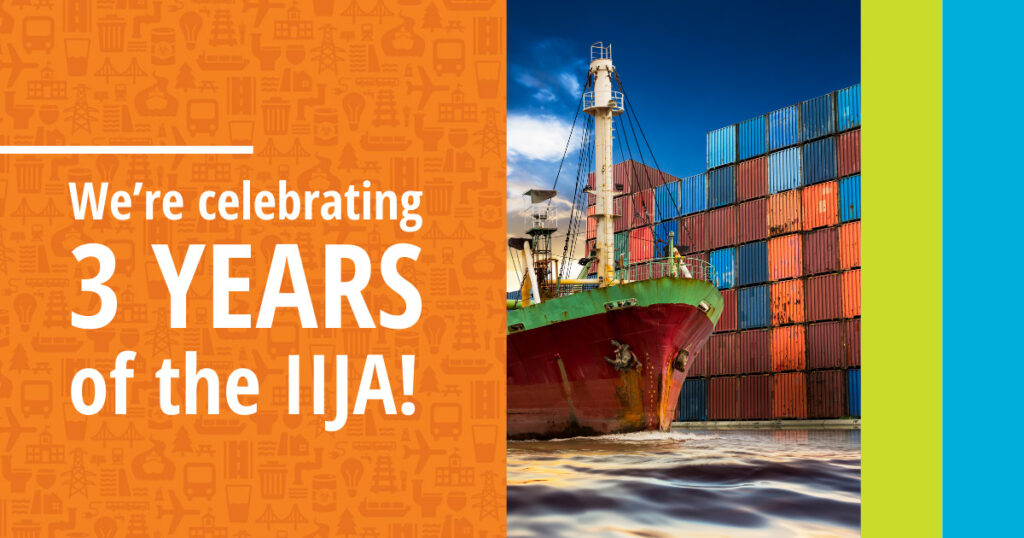Today marks the three-year anniversary of the passage of the Infrastructure Investment and Jobs Act (IIJA), the largest and most comprehensive federal infrastructure investment package in our nation’s history. The law allocated $1.2 trillion, including more than $500 billion in new funding, across each of the 18 categories of infrastructure outlined in ASCE’s 2021 Report Card for America’s Infrastructure.
With broad public support, infrastructure is recognized as vital to protecting public safety and building a thriving economy. Prioritizing the built environment was apparent again on Election Day 2024, as many infrastructure ballot measures passed overwhelmingly in many states and localities.
Three years into the five-year legislation, let’s take a look at some of the progress that has been made.
PROGRAM HIGHLIGHTS
To date, more than 60,000 projects have been announced as part of the IIJA, including:
- More than 10,000 bridge projects connecting communities and improving economic efficiency.
- More than 175,000 miles of roadway repairs or improvements.
- More than 500 port and waterway projects to increase capacity and reliability for the movement of goods.
- Over 11,000 public transit projects to diversify transportation modes and offer alternative solutions to those without vehicles.
- 1,100 airport modernization projects.
- Nearly 170 rail projects to expand and modernize passenger rail and tracks, which are used by both the freight and passenger rail networks.
- More than 1,400 drinking water and wastewater to modernize aging systems and increase public health. This includes replacing up to 1.7 million lead pipes.
- 12,000 miles of high-speed internet infrastructure.
- More than 4,100 projects geared at improving community resilience.
Investment in these systems save taxpayers money in the long run, and we’ve already begun to see the effects. ASCE’s recent economic study, Bridging the Gap, found that on average each American household saves $700 per year when IIJA funding becomes the new baseline for infrastructure investment.
It’s easy to see why. When a manufacturing plant suffers an electrical outage, machines are costly to stop and start, and productivity plummets as workers stand idly by. Meanwhile, congested roadways and outdated freight systems translate to additional time to transport goods. The production of manufactured goods – everything from paper, paints, and food products to electronics, automobiles, and appliances – requires robust and adequately functioning infrastructure. These are just a few examples of how the strength of our built environment has compounding effects on the U.S. economy and individual households, and they underscore how the IIJA is making a difference.
RESILIENCE
The IIJA marked the largest investment in infrastructure resilience – $50 billion over five years – in U.S. history. Recent devastating storms – like Hurricane Helene and Hurricane Milton in Fall 2024 – killed dozens of people and caused significant damage to communities across the entire Southeast. Among lessons learned is the importance of building structures that can withstand even the most severe and unpredictable weather. Ultimately, building to the most stringent codes and standards can prevent tragic loss of life and businesses and saves taxpayers money in the long run – every $1 spent on resilience leads to $6 in returns for taxpayers because the cost of a structure failing is significantly greater than the cost of building stronger on the front end.
The IIJA has addressed these needs by providing $500 million to the STORM Act, which offers low interest loans to those investing in pre-disaster mitigation projects; providing more than $2.5 billion to ecosystem restoration to improve the strength of green infrastructure, which can help mitigate flooding or precipitation; more than $7 billion in flood mitigation projects through agencies such as the U.S. Army Corps of Engineers (USACE), the Federal Emergency Management Agency (FEMA), and the National Oceanic and Atmospheric Association (NOAA); and many more programs.
Resilience is more than the built environment though . The bill targets improving cyber security as a form of resilience to ensure our grid and data are protected from outside threats. Cyber security breaches have been on the rise in recent years, further emphasizing the need for these programs. The bill invests $1.3 billion to increase funding for agencies that assess cyber security concerns, particularly those involved with monitoring the software that controls operations of infrastructure assets.
ONGOING CHALLENGES
Despite significant investment from the IIJA, as well as individual state initiatives improving conditions, challenges remain. Severe weather continues to pummel aging assets, bearing great costs to agencies, infrastructure owners, and businesses. According to NOAA, in 2024, natural disasters have amounted to damages of $24 billion. , which is already billions higher than the average from 2019-2023 ($20 billion/year).
Additionally, the construction sector is still short on the number of engineers needed to see potential projects through, which threatens the impact of the IIJA. ASCE has partnered with the American Council of Engineering Companies (ACEC) and the American Public Works Association (APWA) to create the Engineering & Public Works Roadshow and, most recently, the Engineering Workforce Consortium (EWC), which includes support from nearly two dozen additional industry stakeholders. The Roadshow is an opportunity to highlight projects across the country that demonstrate what smart infrastructure investments look like and how they benefit local communities, the economy, and the environment. The EWC has a singular focus to address and provide solutions to the workforce shortage facing the engineering and public works industries.
With two years left on the IIJA, projects are making a major impact including improving economic efficiency. We look forward to working with the incoming Congress and administration on how to prioritize these investments moving forward.
